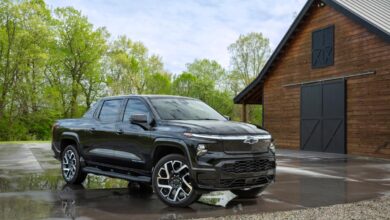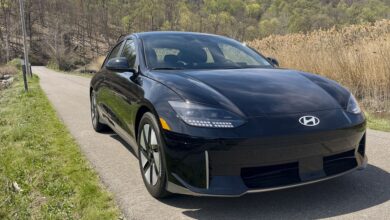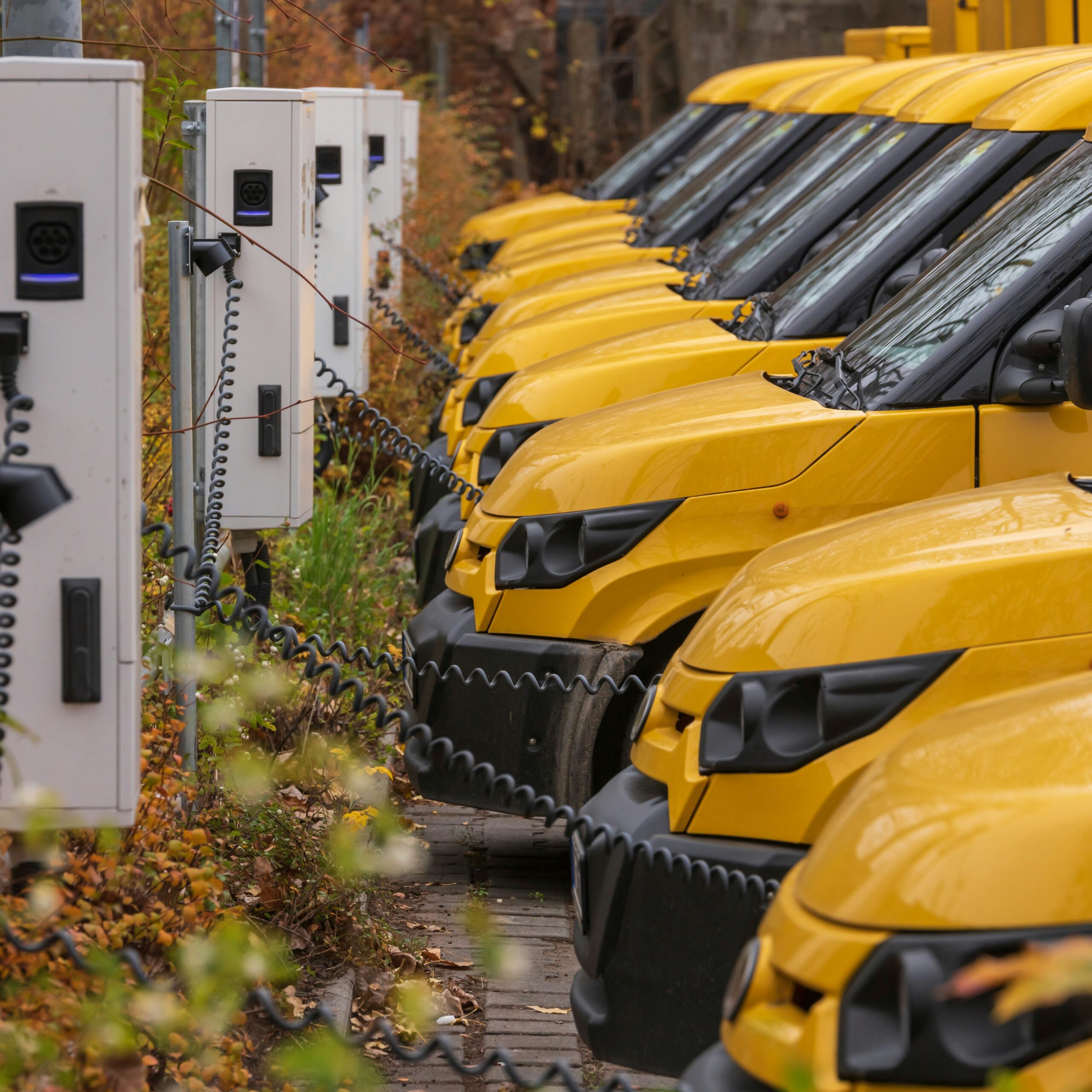Electric transportation takes off in N’West Iowa: Part 3 | News

REGIONAL—Sioux Center resident Robin Van Es was not in the market for a Tesla when she found herself in the driver’s seat of a Tesla Model X at Ver Hoef Automotive in Sioux Center.
“I’ve always driven a Jeep. For years, I loved my Jeep,” the 46-year-old Van Es said. “I just went to go trade my Jeep up, because it was a 2018, and it was getting to have a lot of miles on it.”
Van Es is the second member of her family to own a Tesla. Her 18-year-old son, Brooks McFarland, purchased his Tesla Model 3 in 2022, making him one of the earliest residents in town to drive one of the Elon Musk-led automaker’s electrical vehicles.
“Where Tesla stands apart from every electric vehicle is the technology is just simply unmatched,” McFarland said.
Brooks, who graduated from Western Christian High School this month, enjoys the full self-driving capability of his Tesla, but he became a Tesla owner after he made the case to his parents on financial grounds.
He created a spreadsheet showing he would save $600 a month in gas alone by making the switch to electric.
“He had a Durango that just guzzled gas, and he goes to school in Hull,” Van Es said. “He was spending so much on gas.”
Brooks McFarland opens the door to his Tesla Model 3 outside his home in Sioux Center. The 18-year-old and his mother, Robin Van Es, both drive electric vehicles.
This spring, when McFarland heard there was a used Tesla Model X available for test drives at Ver Hoef Automotive, he convinced his mother to take the electric SUV for a spin. At first, Van Es had misgivings about purchasing an electric vehicle. She was comfortable with the rhythm of fueling up at gas stations, and she had concerns about the logistics of charging.
“I’m like, ‘I don’t know, bud — you have a Tesla,’” Van Es said. “Let’s have one gas car at least.”
However, after test driving the vehicle, which accelerates quickly and features a high-tech user interface in its interior, Van Es began to reconsider.
“We kept it for the weekend and drove it, and it just really was fun — and I’m not one to say, ‘Oh, I love to drive,’” Van Es said. “I just kind of use a vehicle to get from point A to point B.”
She enjoyed the vehicle’s zippy performance, and then she did the math — purchasing the 2019 Tesla, which had been driven only 30,000 miles, would be significantly less expensive than upgrading her 2018 Jeep Grand Cherokee.
“I was like, ‘OK, I think I’m going to go for it,’” Van Es said.
‘They’re just fun to drive’
Van Es is one of a growing number of N’West Iowa residents to embrace battery power as a means of getting around. Increasingly, the region’s roadways are dotted with Tesla Model 3s, Chevy Bolts and Ford F-150 Lightnings, and while the charging infrastructure in N’West Iowa lags behind some other regions — especially on the coasts — charging stations continue to pop up across the Midwest, creating a more robust network for e-powered travel.
“I would say one benefit of being in a place where there are fewer EVs is that I’ve never had to wait to charge,” Sara Tolsma said.
Sara and Jeff Tolsma demonstrate the feature of their electric truck, a Rivian, in the driveway of their Orange City home. The couple installed solar panels on the roof of their house, and they use solar power to charge the two electric vehicles they purchased this spring.
Sara and Jeff Tolsma are residents of Orange City and this spring they decided to take the leap and purchase their first two electric vehicles. Jeff, 60, drives a Rivian, an electric truck designed to appeal to outdoor enthusiasts, and Sara, 61, drives a Tesla Model 3. The couple installed solar panels on the roof of their home to generate most of the electricity needed to power their vehicles. Jeff, who previously enjoyed tooling around in his red Chevrolet Corvette, got behind the wheel of an EV for a test drive and became an instant convert.
“I would say, ‘You’ve just got to drive it — its performance, its handling, its speed,’” Jeff said. “I mean, they’re just fun to drive.”
Sara teaches biology at Northwestern College in Orange City, and Jeff is vice president of human resources at GELITA USA in Sioux City, where he commutes from Orange City every weekday.
“I’m not anti-gas, but we don’t spend anything on gas — zero,” Jeff said.
Rural Sheldon resident Annie McCabe is another early EV adopter in the area. She and her husband, Chris Nuckols, drove self-charging Toyota hybrids for years before she decided to go all-electric. In 2020, McCabe became the owner of a blue Chevy Bolt.
“I love it. I never fill it up with gas. I don’t do any maintenance. I only have to worry about the tires and the windshield wipers, and that is it,” the 48-year-old McCabe said. “And I love not getting gas in the winter.”
Compared to gas-powered vehicles, EVs have fewer moving parts and require relatively less maintenance, including far fewer of the regular oil changes that keep internal-combustion engines in good working order. That was a selling point for McFarland.
Cipa Bulk gets out of her Tesla Model Y in the driveway of her home in Sioux Center. She and her husband, Frank Bulk, both drive Teslas.
“I’ve driven my car for 50,000 miles, and I haven’t had one maintenance, one service,” he said. “There’s an oil recommendation every 80,000 miles. Other than that, there is no maintenance.”
McCabe, too, has been happy with her Bolt — aside from a decrease in her battery’s expected range following a battery recall by Chevrolet. However, she said misperceptions about electric vehicles abound in N’West Iowa.
“There are people who have assumptions that they’re clunky and slow and not fun to drive, and about mine, particularly, that it’s really small inside,” McCabe said. “I’ve had friends — men who are really tall — who are like, ‘I would never drive that thing,’ and then they get in it, and they’re like, ‘Oh, that’s fun.’”
Sheldon resident Jessica Hughes started driving a Tesla in 2018, before her husband’s job in the renewable energy sector drew their family to the wind farms of N’West Iowa.
“We love it. I mean, honestly, we have had basically no maintenance on it,” the 39-year-old Hughes said. “You don’t have to ever have an oil change.”
Jerry Van Es pulls onto highway 75 in Sioux Center in his 2023 Chevy Bolt, a popular entry-level electric vehicle.
The Hughes family has lived in multiple states, but they moved to Sheldon from central Iowa.
“I was driving my kids to school in Des Moines, and it was like a 40-minute drive,” Hughes said. “I went from filling up $100 at least once a week to no fuel bill.”
‘It’s the future’
Most EV owners in N’West Iowa charge their vehicles in their garages, as do 80 percent of Americans, according to the U.S. Department of Energy. However, visitors to the region have access to a growing number of public charging locations. A 50-kilowatt DC fast-charging station was installed at the Fareway in Sheldon in 2019, making it one of the first in the region. Others continue to crop up. In Sioux Center, there is a level-2 charging station at Holiday Inn Express, and plans are in the works to install a public-facing DC fast-charger built at Mouw Motor Co. The dealership currently has a level-2 charger on the property.
“Ours is not a public-facing charger — that’s the next step,” Steve Mouw said.
Mouw is general manager of the Mouw family’s third-generation Ford dealership, which has been at the leading edge of EV sales in N’West Iowa.
The Level 2 charger at Mouw Motor Co. in Sioux Center is not public facing, but there are plans in the works to install a public-facing Level 3 DC fast-charging station on the premises sometime soon.
The push for a more extensive charging network for electric vehicles is reshaping the nation’s roadways, and in Iowa, the Iowa Department of Transportation recently announced it will spend $20 million to $30 million over the next two years on new EV charging stations across the state. The boom in EV adoption has been relatively slow to reach the Midwest, according to Mouw, but state and federal investment in EVs as the vehicle of the future is ongoing.
At the federal level, the Joe Biden administration’s plan for the electrification of America’s transportation system has rolled out unevenly. Biden’s 2021 bipartisan infrastructure package directed $7.5 billion toward the creation of 500,000 federal charging stations by 2030, but the network has been slow to materialize, and only four states have opened stations funded by the program. On the other hand, Biden announced ambitious new automobile emissions standards in March, and the government continues to incentivize the purchase of EVs. Americans who buy new electric vehicles may be eligible for a federal tax credit of up to $7,500, or up to $4,000 if they purchase a used EV Despite a recent slowdown in EV sales, car manufacturers are gearing up for a future that includes more zero-emissions vehicles, Mouw said.
“Ford is investing a lot of money in EV technology moving forward,” Mouw said. “They believe it’s the future.”
Few dealerships in N’West Iowa have entered the electric car market, but Mouw Motor Co. was early to the game. The Ford dealership took the steps to become certified to sell and service EVs in 2020.
A Ford Mustang Mach-E sits in the show room of Mouw Motor Co. in Sioux Center. General Manager Steve Mouw said the leadership at Ford believes electric vehicles are the future.
“We were first-generation Ford EV certified,” Mouw said.
Mouw Motor Co. started selling the all-electric Mustang Mach-E in 2020, and it introduced the F-150 Lightning in 2022.
“The F-150 Lightning is one that we do a little more volume with — it’s a little more mainstream,” Mouw said.
He said customers often come in with misgivings about the performance of EVs, but those misperceptions are quickly resolved once customers get behind the wheel for a test drive.
“They perform like you can’t believe — handling, acceleration,” Mouw said. “And a very low cost of ownership.”
In the United States, record sales of EVs in 2023 were followed by a relative slowdown in the first quarter of 2024, and Ford has decelerated its timeline for ramping up EV production accordingly.
“They have pulled the reins back a little bit, because the demand hasn’t quite been there like they thought it would be — in the Midwest, especially,” Mouw said. “On the coasts, the climate is better, and also the infrastructure is bigger.”
Cold weather reduces battery life and decreases the number of miles an EV can travel when fully charged.
Mouw said he thinks the recent slowdown in sales is likely temporary, partly a consequence of an initial spike in purchases by early adopters, and not necessarily indicative of future trends.
“People have this feeling that demand is waning, and it might be somewhat,” he said. “But 2023 was a record year for sales — ever.”
Mouw said gas-powered vehicles are not going away anytime soon, and Ford will continue to produce gasoline- and diesel-engine vehicles in the future. However, the company continues to add to the billions it has invested in electric power.
“Ford is building a new facility in the Tennessee area where they’re producing their own batteries — it’s all self-contained,” Mouw said. “They invested several billion dollars to try to keep it all in house, and hopefully, lower costs and improve availability.”
He said it likely will be a while before EVs really take off — especially in the Midwest — and to date, he has only sold about a dozen electric vehicles off his lot.
“The technology needs to continue to improve — battery life with cold climates — as well as the infrastructure, and we need to have costs come down,” he said. “That’s really going to make it more mainstream as the cost becomes affordable. Get them under $30,000 — that is going to be a big deal.”
‘People will be demanding it’
Affordable entry-level EVs already are hitting the market, however, and models like the Chevy Bolt are becoming more accessible. Sioux Center residents Jerry and Kim Van Es decided to purchase a 2023 Bolt last April because its price tag, which was under $30,000, made it more appealing than other models on the market.
Brooks McFarland and his mother, Robin Van Es, stand between their two electric vehicles in the driveway of their home in Sioux Center. Van Es was not in the market for an electric vehicle, but her son convinced her to take a 2019 Tesla Model Y for a test drive and she ended up buying it.
“We’re using this as kind of a second car, just for around town, so we thought, ‘We don’t want to put $60,000 into it,’” the 74-year-old Jerry said. “It’s the go-to for shorter trips, and if we go to Sioux Falls, we take it.”
Along with the falling prices of entry-level EVs, other shifts have made electric vehicles a more appealing option to consumers, even in rural regions. “Range anxiety,” a recent phrase to enter the vernacular, is becoming a thing of the past as a more reliable and extensive charging network develops across the country.
Sioux Center resident Frank Bulk is chief technology officer at Premier Communications in Sioux Center, and he bought his first Tesla Model 3 in 2019, largely because he was excited about the company’s pursuit of fully autonomous driving. Frank is now on his third Tesla, and his wife, Cipa Bulk, got her first, a Model Y, in 2020. The Bulks said they have not had trouble with charging, even on long road trips.
“It’s gotten easier,” the 48-year-old Frank said.
“We’ve driven all the way to Florida,” the 51-year-old Cipa said. “We’ve driven all the way to Canada, all the way to Arizona — twice. Many people freak out because they don’t know how they can charge and all that. But, basically, if you put your destination in the car, the car will tell you where to stop and charge.”
Tesla’s proprietary app directs users to charging stations in its Supercharger network, which is the largest in the United States. Other proprietary networks are being developed, too, including Ford’s BlueOval Charge Network, and adapters are making it easier to switch among them. Furthermore, if automakers make good on their promise to switch to Tesla’s charging connector in the next few years, charging EVs will become even simpler.
“Tesla’s charging network is the best in the nation,” Frank said. “If you didn’t have that, it would be harder to get around.”
Sioux Center resident Frank Bulk keeps his eyes on the road while utilizing the full self-driving capability of his Tesla Model 3. Bulk is one of many N’West Iowa residents who currently drive Teslas or an elective vehicle on area roadways. He bought his first Tesla in 2019, and his wife got one in 2020.
Robin Van Es said longer trips take more planning with an EV, but she’s getting more confident about venturing farther from home. On trips out of town, she often seeks out Tesla Superchargers, which add up to 200 miles of range in 15 minutes.
“Tesla tells you exactly where the chargers are. It’s on a display, and it will tell you exactly the percentage of charge you need to get there — but you do need to plan,” Van Es said.
Sara Tolsma said she has only run into trouble finding a charging station once, on a trip through Spirit Lake, where her parents live, to a plant nursery in Jackson, MN.
“That direction is a charging desert,” she said. “I’m shocked that there’s not a Tesla charger in Spirit Lake given all the tourism. That is probably coming pretty soon, though, because people will be demanding it.”
On all her other trips, though, Sara said she does not mind the charging routine, and she sees it as an opportunity to be deliberate about planning stops.
“We found that we kind of enjoy it, because we slow down a little bit,” she said.
The Tolsmas make frequent trips to Kansas City, where their son lives, and during charging stops, they often get lunch, or browse the aisles at a nearby Target.
“It’s charged in that 30 minutes back to 100 percent,” Jeff said. “It’s not a pit stop, like, ‘Hey, everyone hit the bathroom.’ It is longer. But you just plan for that.”
The way McFarland sees it, there is only upside for EV owners in the future.
“Right now, it’s the worst it’s going to be,” McFarland said. “It’s only going to get way more convenient — and the more EVs there are on the road? It’s just going to get better.”



